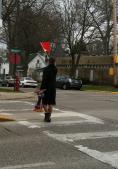






Madison neighborhoods address pedestrian safety amidst growing car traffic.
Standing on a busy street corner with no traffic lights in sight, Madison-area pedestrians wave a red flag while crossing the street.
UW-Madison student Brock Fritz says the flags are successful at making cars more aware of people.
“I kind of wait for the traffic to calm down before I step into it. I’m not one to make the first moves as the pedestrian, even if I have the flag in my hand” said Fritz. “I think the flags do their purpose to make cars aware of the people, but the pedestrian has to put their foot out their first.”
 ©Dudgeon-Monroe Neighborhood Association.Pedestrian flags began appearing in Madison in 2003 through the efforts of the Safe Community Coalition of Madison and Dane County. The program, officially known as “Pedestrian Flags Over Dane County Adopt-A-Crosswalk,” has now implemented the flags at 50 intersections that may not be suitable for traffic signals but can be difficult for pedestrians to cross.
©Dudgeon-Monroe Neighborhood Association.Pedestrian flags began appearing in Madison in 2003 through the efforts of the Safe Community Coalition of Madison and Dane County. The program, officially known as “Pedestrian Flags Over Dane County Adopt-A-Crosswalk,” has now implemented the flags at 50 intersections that may not be suitable for traffic signals but can be difficult for pedestrians to cross.
The flags facilitate communication between a pedestrian and a driver. At uncontrolled intersections in Wisconsin, drivers are required to yield to pedestrians with at least one foot in the street. In the hands of a pedestrians, the red flags serves both to enhance their visibility and assert their intent. While the flag doesn’t automatically make drivers stop, it generally makes crossing the street faster, safer, and easier.
People wanting to cross the street simply grab a red flag from its container and point it across the street to signal their intent to the oncoming motorists. Once traffic yields, the pedestrian crosses the street with flag in hand. The pedestrian then places the flag in its container on the opposite side of the street for the next person to use.
During a recent Common Council candidate debate, speeding on local roads was cited as the “most frequent complaint” made to alders. Sue Ellingson, who is now the alder of District 13, suggested the Monroe Street flags are efficient at calming by encouraging pedestrian crossings.
“Having people cross the street all the time gets people clued in that this is going to happen and you need to slow down here,” said Ellingson.
Pedestrian flags represent a distinct alternative to other methods of intersection control and traffic calming, such as speed bumps, stop signs, or traffic islands. Material costs for flags are much lower and installation/removal is much easier. Conversely, the flags are more vulnerable to theft and seasonal wear. For these reasons, flag kits often require daily monitoring by local business owners and residents.
The “user-activated” nature of the flags also contrasts “all-day” options like stop signs, which impact traffic regardless of necessity. The inappropriate installation of stop signs has been linked to the encouragement of driver noncompliance.
“Stop signs are ineffective if there isn’t enough traffic,” Ellingson said. Traffic behavior research has revealed that drivers are more inclined to do “rolling stops” when stop signs are placed in areas with low traffic. “It’s all about training the drivers,” Ellingson said, “training the drivers to slow down and pay attention.”
“I think the flags work, I see people use them a lot,” said Fritz. “As a pedestrian it makes crossing the street a lot easier and quicker than before. As a driver it doesn’t slow down the traffic that much either. I mean you have to wait for one or maybe two pedestrians to cross and then you can resume driving again. Who would complain about that?”
Census 2010 results have shown that Dane County added more residents than any other county in Wisconsin over the past 10 years. As neighborhood roads around Madison serve more pedestrian trips and car trips than ever before, pedestrian flags offer a means of minimizing the conflict between them.
|
|
|
Welcome to the Madison Commons, a website designed to provide news and information about all of Madison's neighborhoods and a crossroads for the discussion of community issues. The name comes from the idea of a village commons, a place for news, talk, debate, and some entertainment, too, that's open to everyone.
All rights reserved. Read more about the Madison Commons and its partners.

